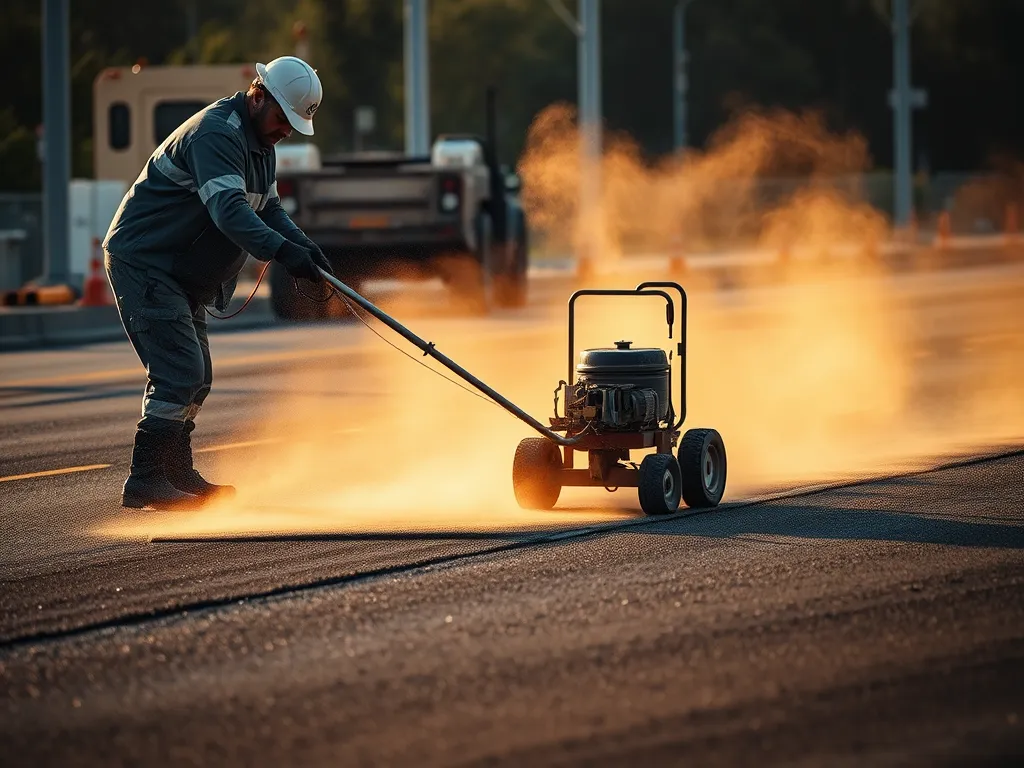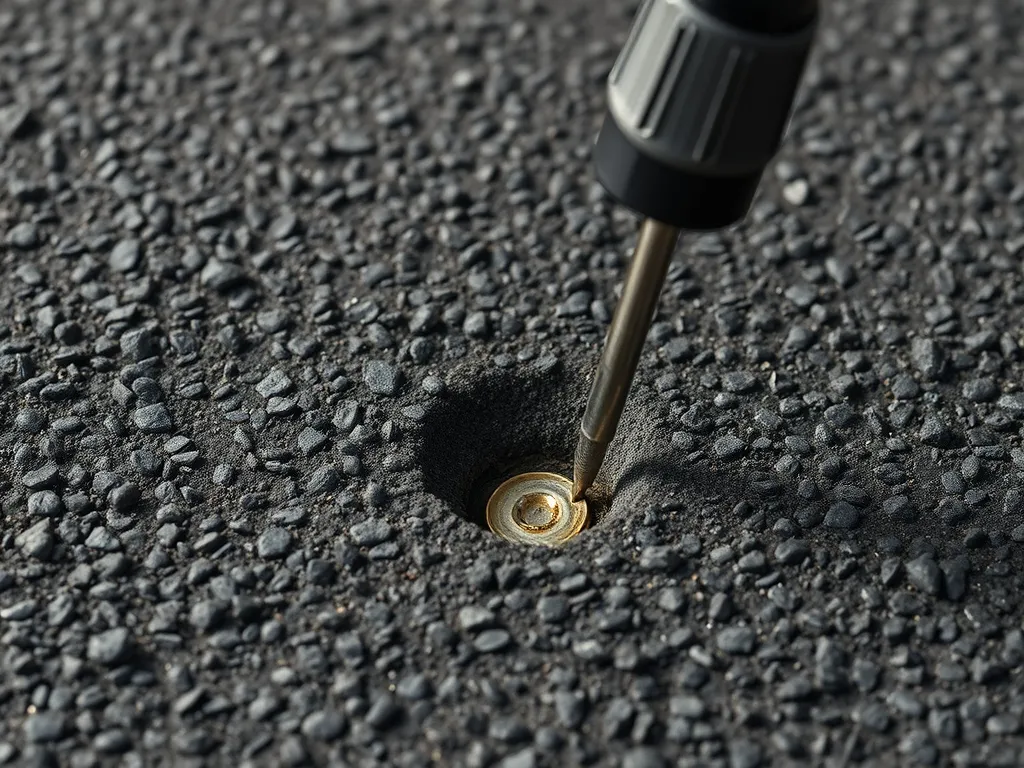Cold Mix Asphalt Durability Over Time: What You Need to Know
Published on: October 15, 2025 | Last Updated: April 14, 2025
Written By: George Voss
Cold mix asphalt provides temporary to mid-term durability, lasting 6 months to 5 years depending on traffic, weather, and maintenance. Made with emulsified asphalt binders that cure at ambient temperatures, it’s designed for quick repairs and low-traffic areas like driveways or potholes. Unlike hot mix asphalt (which uses heated liquid asphalt for immediate strength), cold mix stays pliable until compacted, offering flexibility but requiring strategic use for optimal longevity.
This article explains how cold mix asphalt performs under real-world conditions. We break down how UV exposure, freeze-thaw cycles, and traffic volume affect its lifespan. Compare drying times (24 hours to 3 weeks) and hardness levels against traditional asphalt. Learn why proper compaction boosts durability by up to 40%. Get actionable tips for extending pavement life through sealcoating and drainage fixes.
Contents
- Introduction to Cold Mix Asphalt Durability
- Key Factors Influencing Cold Mix Asphalt Durability
- Cold Mix Vs. Hot Mix Asphalt: Durability Comparison
- Cold Mix Asphalt Lifespan: Expectations and Realities
- Maximizing Cold Mix Asphalt Longevity
- Environmental Impact and Sustainability
- Frequently Asked Questions (FAQ)
- Closing Thoughts
- Additional Resources for You:
Introduction to Cold Mix Asphalt Durability
Cold mix asphalt offers a flexible solution for road repairs in diverse conditions. Its ability to perform without high-temperature mixing makes it a go-to choice for temporary fixes and remote projects. But how does it hold up long-term?
What is Cold Mix Asphalt?
Cold mix asphalt combines aggregates (crushed stone, sand) with bitumen emulsion or cutback asphalt. Unlike hot mix, it requires no heating during production. This blend stays workable for months, giving it a shelf life of 6-12 months when stored properly. Common applications include pothole repairs, utility cuts, and rural road patches. Additives like polymers or latex boost cold mix asphalt resilience, meeting standards like ASTM D4215 for quality control.
Why Durability Matters for Asphalt Applications
Durability directly impacts safety, repair costs, and project timelines. Cold mix asphalt longevity determines how often crews must revisit sites—a critical factor for roads handling 500-2,000 vehicles daily. In residential areas, properly installed cold patches last 1-3 years; commercial sites may see faster wear. Weak durability leads to raveling, cracking, or moisture damage, forcing repeat repairs at $25-$50 per square foot. High-quality cold mix with 3-5% polymer content resists these issues, maintaining structural integrity through freeze-thaw cycles.
Next, let’s break down the elements that shape cold mix asphalt performance across different environments.
Key Factors Influencing Cold Mix Asphalt Durability
Cold mix asphalt longevity depends on five core elements. Each plays a role in how well it holds up under stress.
Weather and Environmental Exposure
Sun, heat, cold, and water shape cold mix asphalt resilience. These forces act year-round.
Impact of UV Rays on Cold Mix Asphalt
UV rays break down bitumen binders over time. This weakens the mix, causing cracks. Polymer-modified blends resist UV harm better, lasting 15% longer in sunny zones like Arizona or Texas.
Effects of Temperature Fluctuations
Freeze-thaw cycles split cold patch asphalt. Water seeps in, freezes, and expands. Northern states see 20-30% faster wear vs. mild climates. Mixes with rubber additives handle swings better.
Water and Moisture Resistance
Poor drainage cuts cold mix lifespan by half. Sealants block water entry. Open-graded blends let water flow through, reducing damage risk.
Traffic Load and Usage Patterns
Car weight and speed matter. A home drive sees 2-4 cars daily. A store lot handles 200+. Heavy trucks (8,000+ lbs per axle) stress patches faster. High-traffic zones need 2-inch thick layers vs. 1-inch for light use.
Material Quality and Composition
Cheap mixes fail fast. Top-grade cold patch uses:
- PG 64-22 bitumen (sticks better in cold)
- 3/4″ crushed stone (locks in place)
- 6% binder content (less raveling)
Low-quality stone or 4% binder drops life by 1-3 years.
Installation Techniques and Compaction
Poor setup ruins even good mixes. Key steps:
- Clean holes with air blasts
- Layer fills 2″ at a time
- Compact with vibratory plates (92% density)
Hand-tamping gives 30% less density. Apply above 50°F for best bond.
Maintenance Practices Over Time
Fix small cracks fast. Sealcoating every 2-3 years blocks water. For potholes, dig out loose bits, add fresh mix, and compact. Proactive care adds 3-5 years vs. reactive fixes.
Next, see how cold mix stacks up against hot asphalt in real-world use.

Cold Mix Vs. Hot Mix Asphalt: Durability Comparison
Choosing between cold mix asphalt and hot mix asphalt hinges on durability needs. While both use aggregates and bitumen, their production methods create distinct performance profiles. Cold mix skips high-temperature heating, relying instead on emulsified asphalt binders. Hot mix requires 300°F+ temperatures to activate the binder fully.
Lifespan Differences Between Cold and Hot Mix
Hot mix asphalt typically lasts 15-20 years with proper maintenance due to its dense compaction and thermal bonding. Cold mix asphalt longevity ranges from 2-5 years, making it better suited for temporary repairs or light traffic. Freeze-thaw cycles and UV exposure degrade cold mix faster, reducing its resilience against cracking and raveling. For high-stress areas like highways, hot mix remains the standard.
Application-specific Durability Considerations
Cold mix asphalt excels in low-traffic scenarios. Pothole patching with products like QPR (Quick Patch Repair) or UPM (Universal Permanent Mix) offers immediate fixes without heating equipment. Driveways, rural roads, and winter repairs benefit from cold mix’s flexibility in temperatures as low as 20°F. Hot mix dominates heavy-load applications—think interstate highways or airport runways—where structural integrity trumps convenience.
Cost Vs. Longevity Trade-offs
Cold mix asphalt costs $25-$50 per ton versus hot mix’s $100-$150 per ton. Installation savings add up: no need for rollers or hot-box equipment cuts labor by 30-50%. But frequent reapplications erode savings over time. A single hot mix repair might outlast three cold mix patches. For budget-limited projects or remote locations, cold mix’s shelf life (up to 6 months unopened) and recyclability—up to 100% reused—balance short-term gains against long-term needs.
These comparisons set baselines, but real-world cold mix asphalt performance depends on factors like curing time and maintenance rigor. Next, we’ll break down lifespan expectations under varying conditions.
Also See: Does Asphalt Driveway Increase Property Taxes?
Cold Mix Asphalt Lifespan: Expectations and Realities
Cold mix asphalt offers fast fixes but faces myths about its staying power. Let’s break down how it performs year after year.
Average Lifespan Of Cold Mix Asphalt
Cold mix asphalt lasts 2-5 years based on use and care. Shelf life matters too – unopened bags stay workable for 6-12 months if stored right (50-80°F, dry).
How Long Does Cold Mix Asphalt Last? (Residential vs. Commercial Use)
Home driveways see 3-5 years with light cars and upkeep. Parking lots with trucks? 1-3 years max. A study by NAPA found cold patch in high-traffic zones fails 60% faster than low-use areas.
Drying and Curing Process
Cold mix hardens through evaporation, not heat. Moisture leaves slowly, bonding sand and bitumen. Full strength takes weeks – rush it and cracks form fast.
How Long Does Cold Patch Asphalt Take to Dry?
Walk on it in 24-72 hours. Drive? Wait 3-7 days. Full cure needs 6-12 months. Winter slows drying – 40°F temps can double set time.
Does Asphalt Cold Patch Ever Get Hard?
Yes, but not like hot mix. Properly laid cold patch hits 90% hardness of hot asphalt after curing. Test it: a screwdriver shouldn’t pierce deeper than 1/4 inch in set mix.
Signs Of Deterioration and Failure
Watch for edge cracks within 6 months – early wear flags. Potholes mean base layers failed. Surface raveling (loose stones) signals bitumen loss. These demand quick fixes to prevent total breakdown.
To stretch your cold mix lifespan, smart upkeep beats reactive repairs. Next: proven ways to boost performance year after year.

Maximizing Cold Mix Asphalt Longevity
Proper care and strategic upgrades keep cold mix asphalt functional for years. Focus on three core strategies: proactive monitoring, targeted repairs, and structural enhancements.
Routine Inspection and Preventive Maintenance
Check surfaces every 3-6 months for cracks, potholes, or uneven areas. Address issues early to prevent water infiltration, which weakens the base layer. Use sealcoating every 2-3 years to block UV damage and oxidation. Sweep debris monthly to avoid abrasion from gravel or leaves. For driveways with light traffic (1-2 cars daily), apply a rejuvenating emulsion annually to restore flexibility.
Effective Repair Techniques for Prolonged Durability
Fix potholes using cold mix asphalt with 95% compaction rates. Square edges around damaged zones to create stable repair boundaries. For cracks wider than ¼ inch, employ a mortared asphalt patch with polymer-modified binders. Always layer repairs: fill 2 inches at a time, compacting each pass with a vibratory plate. Avoid stockpiling unused mix beyond its 6-month shelf life, as aged binders lose adhesion strength.
Resurfacing and Reinforcement Strategies
Add a 1.5-inch overlay every 8-10 years on high-traffic areas (500+ vehicles/day). Embed geotextile fabrics between layers to distribute weight and reduce rutting. Install edge restraints like concrete curbs to prevent lateral spreading. For commercial lots, reinforce bases with 6-8 inches of crushed aggregate to handle loads up to 40,000 lbs. These steps boost cold mix asphalt lifespan by 30-50% compared to unreinforced surfaces.
Proactive upkeep paired with structural upgrades ensures cold mix asphalt stays resilient under stress. Next, let’s explore how these durable surfaces also support eco-friendly goals through recyclability and energy efficiency.
Environmental Impact and Sustainability
Cold mix asphalt offers green perks that grow as it ages. Its low-heat prep cuts fuel use, while its built-to-last design slows wear from cars and weather.
Recyclability Of Cold Mix Asphalt
Cold mix can be reused up to 100%. Old roads or scraps get ground into new mix, saving 3.2 million tons of waste yearly in the U.S. This loop keeps costs low – recycled stock costs $12-$18 per ton vs. $45 for new rock. Plus, reused bits bond tight with fresh binders, keeping cold patch asphalt durability strong over 5-7 years.
Eco-friendly Advantages in Long-term Use
Cold mix needs 30% less energy than hot mix since no heat is used. Over a decade, one mile of road made with it cuts 18 tons of CO2 – equal to 42,000 car miles. Its open pores let rain soak in, slashing flood risks by 40% in paved zones. LEED jobs pick it for up to 6 credits due to low fumes and high recycle rates.
Want to see how these green gains affect real-world use? We’ll break down key FAQs next.

Frequently Asked Questions (FAQ)
How Long Does Cold Patch Asphalt Last?
Cold patch asphalt typically lasts between 2 to 5 years, depending on factors like traffic volume, environmental conditions, and installation practices. In residential areas with light traffic, it may last closer to the upper end of that range, while in high-traffic locations, it may wear out more quickly.
What Are the Disadvantages Of Cold Mix Asphalt?
Cold mix asphalt tends to have a shorter lifespan compared to hot mix asphalt. It can also be more prone to deformation under heavy traffic and is susceptible to weather conditions like freeze-thaw cycles, which can lead to cracking and raveling if not maintained properly. Furthermore, it generally requires more frequent repairs and has lower durability in high-stress applications.
What is the Life Span Of Asphalt Compared to Cold Mix?
Hot mix asphalt can last anywhere from 15 to 20 years with appropriate maintenance, while cold mix asphalt usually lasts only 2 to 5 years. The difference in lifespan largely stems from their production methods and composition, with hot mix providing greater strength and durability suitable for high-traffic areas.
Closing Thoughts
Cold mix asphalt offers unique advantages, especially in terms of versatility and ease of application. Its durability over time can vary based on several factors, such as environmental exposure, traffic loads, and material quality. By understanding these influences and implementing effective maintenance practices, you can significantly extend the lifespan of cold mix asphalt surfaces.
While cold mix isn’t always a one-size-fits-all solution, its affordability makes it an attractive option for both residential and commercial projects. Regular inspections and timely repairs can enhance its performance, ensuring it meets the demands of fluctuating weather and heavy traffic.
For further insights on optimizing asphalt projects and calculating material needs, check out Asphalt Calculator USA.
Additional Resources for You:
- National Asphalt Pavement Association (NAPA, Industry Reports & Best Practices)
- Hot Mix Vs. Cold Mix Asphalt: What’s The Difference?
- Hot Mix Vs. Cold Mix Asphalt: Which One Is Better For Your Road Project? – LeeBoy®
- Hot Mix Asphalt vs. Cold Mix Asphalt – Walt’s Paving
- UPM® Cold Mix Asphalt Patch | Cold Patch Asphalt Repair | UNIQUE Paving Materials


